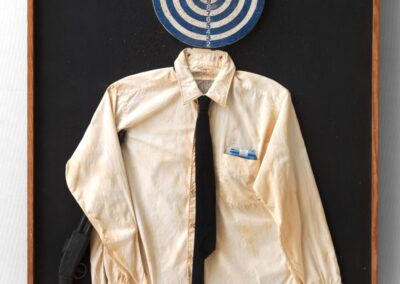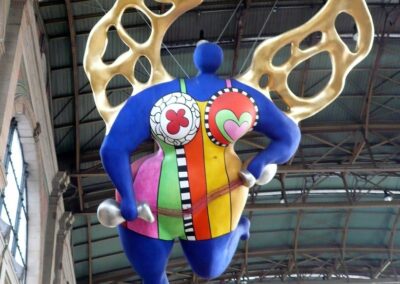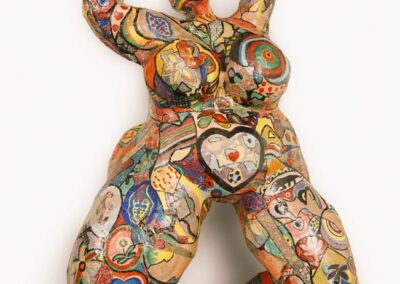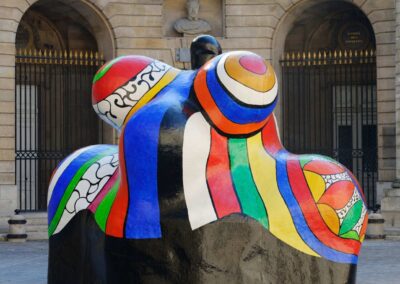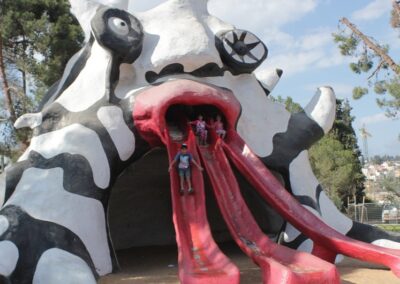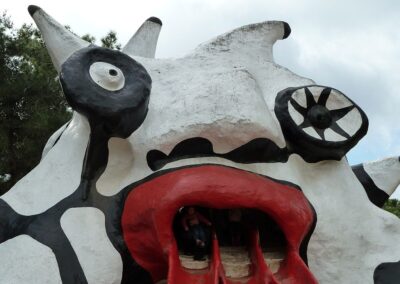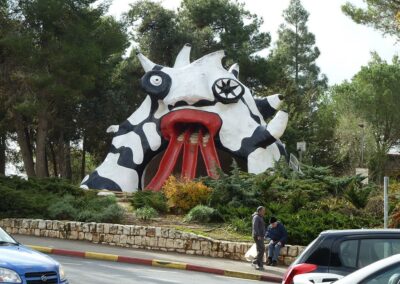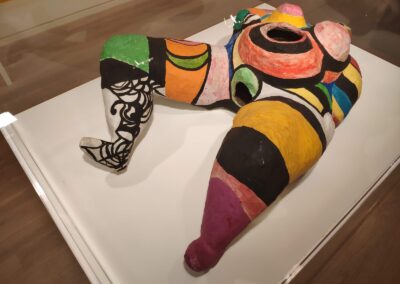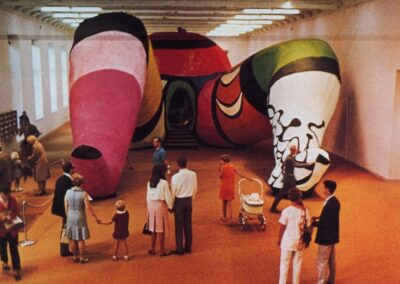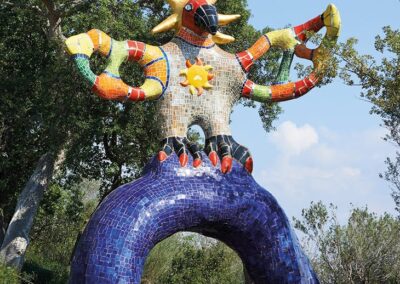Our next Artist You Need To Know is Niki de Saint Phalle (1930 – 2002).
A French – American sculptor, painter, filmmaker, and author of colorful hand-illustrated books, she was born Catherine Marie-Agnès Fal de Saint Phalle. She is recognized as one of the few female artists to work in monumental sculpture during her lifetime. Saint Phalle’s unique aesthetic and very recognizable style has been often placed under the umbrella of ‘outsider art’ : this may be due to the fact that she had no formal training but often collaborated with and was part of a larger community of many significant contemporaries in a variety of media.
Saint Phalle’s career can be split into two major phases. The first half of her career is often described as the ‘Feminist Wrath’ works : paintings and mixed media work that became part of performances involving firearms. These gave way to the “Nanas, light-hearted, whimsical, colorful, large-scale sculptures of animals, monsters, and female figures. Her most comprehensive work was the Tarot Garden (1974–1998) , a large sculpture garden containing numerous works ranging up to house-sized creations.” (from here)
These are artworks that many art historians expound as a “Feminist celebration of femininity through sculptures of female bodies in fibreglass and polyester resin, which were frequently enormous.” (from here) Her many installations that create environments that both envelop and dwarf the visitor, in a manner of a theme park or circus, are the works for which Saint Phalle is loved by many.
Saint Phalle was born near Paris : her father was a French aristocrat and banker father and her mother was American. The depression of the 1930s was impacting France and her family moved to the United States when she was a child. After some time in Connecticut Saint Phalle’s family would move to New York where she spent the majority of her formative years. But “it was an era however blighted by a strictly religious and abusive mother and the sexual abuse of her father which began long before Saint Phalle had even reached adolescence.” (from Women’s Art Blog)
She was labelled a ‘rebellious teenager’, transferring from a number of private girls schools and being expelled from at least one. But this also was a factor in her early embrace of feminism as a response to how both she – and women, as a whole – were treated by society.
Before beginning to make art, Saint Phalle worked as a successful model and appeared in a number of the top fashion magazines of the time. She married and became a mother, and she and her family moved to Europe (dividing time between France and Spain). As she began to paint, her influences included Gaudi, Abstract Expressionists and the nascent Pop art movement.
Saint Phalle began painting large works that incorporated both these influences and symbology from her own repressive religious upbringing. She also incorporated objects into these works, including household items, and the works took on aspects of both icons and alters. During this period ‘happenings’ – performance art – were also emerging as a movement in Western art, and she often staged events where she would shoot at her own creations with guns. The outrageous nature of these action works drew attention to her practice, and “she was soon making a name for herself in what was fast becoming a post-modern art world which encouraged the crossing of boundaries and bold acts of rebellion. By the 1960s she was exhibiting in New York and a number of prestigious international venues.” (from here) In speaking about these works, Saint Phalle offered : “I was shooting at myself – I was shooting my own violence and the violence of the times.”
Her work became less about violence as her practice evolved, and she began to create large female figures that were impressive in scale and colour, with a dynamism of movement and action. Saint Phalle initially worked with female stereotypes as a point of departure, such as tropes of motherhood or old crones. She stated that “I love the round, the curves, the undulation, the world is round, the world is a breast.”
Saint Phalle’s figures are often “fanciful explorations [of] exquisitely rotund Venus-like figures in multicoloured guises, joyfully leaping or ecstatically dancing. The name ‘nanas’ applied to these sculptures refers to a French slang term for women equivalent to English derogatory words such as ‘birds’ or the US version ‘chicks’. The artist reclaimed such terms, subverting their meaning and thus liberating her spectacular larger than life goddesses.” (from here)
One of the more amazing works from this period was from 1966 when Saint Phalle “created a momentous lying figure representative of a pregnant woman which the gallery viewer could enter via a doorway in the vagina. It was a daring and groundbreaking work for the age.” (from here)
We have several images of this work (titled She – A Cathedral) below.
The two works below are The Golem (1972) and She – A Cathedral (1966). More information about She can be found here, and an Atlas Obscura post about The Golem is here.
“I’m following a course that was chosen for me, following a pressing need to show that a woman can work on a monumental scale.”
From here : “Saint Phalle’s creativity captured the imagination of both the artworld and her viewership. One of her last projects was typically momentous and took influences from Gaudí’s Parc Güel. In 1998, The Tarot Garden, a sculpture garden featuring many of her largescale creations….the work included, for example, The Empress, a huge nana-sphinx. By this time, however, the artist’s health was failing, in part impacted by the materials she had worked with in her practice over the years [including fiberglass]. The Tarot Garden was completed, nevertheless, according to her plans and wishes.”
The images below are various scenes from Saint Phalle’s Tarot Garden : a fine video tour can be enjoyed here. Tarot Garden is located in Pescia Fiorentina, località Garavicchio, in the municipality of Capalbio, province of Grosseto, Tuscany, Italy. The park was opened to the public in 1998.
The words of the artist : “The Tarot Garden is not just my garden. It is also the garden of all those who helped me make it. I am the Architect of the garden. I imposed my vision because I could not do otherwise. The garden was made with difficulties, wild enthusiasm, obsession, and most of all faith. Nothing could have stopped me. As in all fairy tales, before finding the treasure, I met on my path dragons, sorcerers, magicians, and the Angel of Temperance.”
“I wanted to make some of the really important things of my generation and some of the biggest.”
Saint Phalle also, in the 1970s, began to experiment with film, which is a logical extension of her performative works and her sculptures that have a vivid, almost living quality. A significant work from this period was the horror film Daddy, that spoke of her own childhood abuse at the hands of her father. She would also publish her memoirs in the final years of her life – Mon Secret – which further explored and exposed her history of trauma and abuse.
Significant exhibitions of her work within gallery spaces have been mounted at Mingei International Museum on The Prado, Balboa Park, San Diego, California (1998), Sprengel Museum, Hannover, Germany (2000), a retrospective in 2002 at Museum of Modern and Contemporary Art (MAMAC), Nice, France, Grand Palais, Galeries nationales, Paris, France (2014), Arken Museum of Modern Art, Ishøj, Denmark (2016), MoMA PS1, Queens, New York City (2021) and the Museum of Contemporary Art San Diego (2021 – 2022)
But Saint Phalle is truly best known and loved for her public art installations and the massive sculptural environments she created over her life and career. In the words of the artist : “It’s my destiny to make a place where people can come and be happy: a garden of joy.”
Saint Phalle died in 2002. Much more about her life and work can be enjoyed here at the Niki Charitable Art Foundation and here at The Art Story.
A documentary about her life and work can be seen here.

